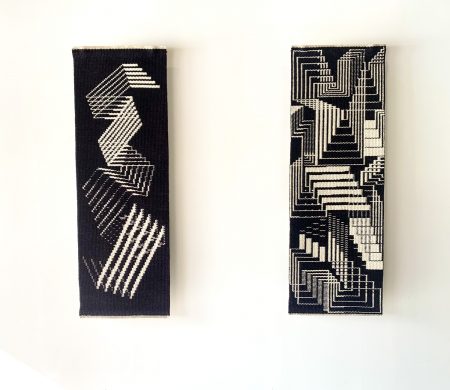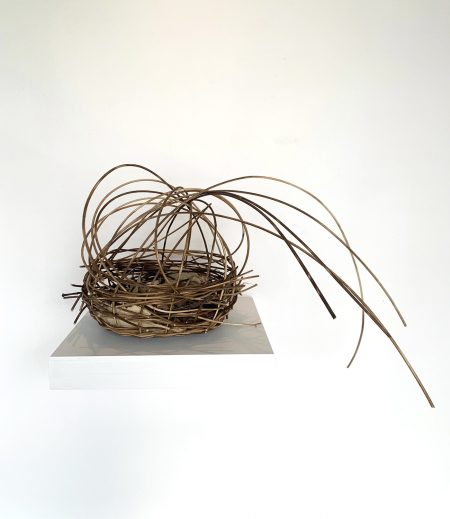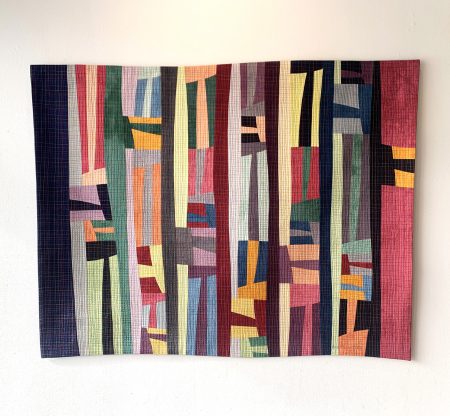
How do we define a grid?
When does an artist find it desirable to exploit the grid’s rigid constraints? And when is it more interesting to modify or even reject them?
This exhibit educates about forms and formats of fiber art. Immediately catching the gallery visitor’s eye are two black-and-white weavings that their makers call rugs. Are they really rugs? That depends on whether you consider these skillfully designed and executed pieces suitable for your rescue pet to wipe its feet on. But, yes, they have the heft of floor coverings and could be utilitarian.

Having the decorative potential of tapestries but constructed differently, the rugs are the collaboration of McCrystle Wood and Melissa Lusk. Wood is a professor emerita of art and design (DAAP, UC), and Lusk serves as president of the Weavers Guild of Greater Cincinnati. While the design tasks are Wood’s, they are both weavers, though their partnership has evolved to the point where Lusk does most of the loom work as well as the hand dyeing of the wool weft yarns.
At its simplest, a woven cloth is the interlacing of the warp (passive and usually under tension) and weft (active and inserted crosswise). In what is called plain weave, it’s the arrangement of threads in an over-one-under-one pattern, exactly like those construction-paper placemats you wove in elementary school. But there are many variations. Many.
Wood and Lusk have stuck with the inherent grid in loom weaving as well as perturbed it, specifically by training themselves to weave in a technique called shaft-switching, just one of those many variations. A complex structure requiring a specially adapted loom, shaft-switching and the devices to do it are an invention of the pre-eminent British artist-weaver Peter Collingwood, now deceased.
Since meeting about five years ago and discovering their artistic compatibility and mutual interest in learning to weave, Wood and Lusk have refined their designs and vastly improved their skills and acquired some very sophisticated equipment. Lusk refers to her loom collection as her herd. Some of the animals in the stable are enormous. One is computer driven.
In fact, there would be none of this team’s artworks without Wood’s computer, where the bold geometric images which simulate three-dimensionality are generated. Recently they have been working exclusively in black and white, a restriction that seems to create more impact than the similar designs they executed in multiple colors. The two rugs in this show have the Wood-Lusk hallmark of optical illusions expertly fabricated in the best possible materials.
Long-time Weavers Guild member and a former president, Judy Dominic is an internationally renowned instructor and exhibitor in a multitude of techniques. Dominic began her exploration of fiber as a traditional loom-weaver. Then she started making baskets, eventually heading the Midwest Basketry Focus and organizing their conferences. Along the way, she became an expert in bògòlanfini, handwoven cotton cloth decorated with fermented mud that originated with the indigenous people of Mali.
Dominic now is “into” using natural dyes to embellish repurposed garments and new wearables. She is, or has been, a book artist, a paper maker, a spinner, a felter, a knitter, and a collagist. A regular forager for natural materials, she doesn’t shy away from employing some surprising elements like the pig gut and dried soil in her sculptures in this show. This artist is never one to ignore the shapely twig, the bag of zippers, the pile of junk mail, or the ephemeral, insignificant, or discarded. Odds and ends are her media and inspiration.

Among the artworks in this exhibit, Dominic’s are truly three-dimensional. Though baskets have warp and weft—yes, here, too, there’s an underlying grid—she defies that limitation and has constructed pieces that seem to flow, spill, scrunch, bind, and sway. Some of her wall-hangings suggest grids yet are intersections that are nothing like graph-paper patterns. As convincing evidence of her foraging habit, one basket envelops a particularly handsome branch. You can imagine her delightedly spiriting it home from the woods!
There are people who see a quilt and ask Why. Why cut up perfectly good fabric and then stitch it back together? There are people who see an art quilt and ask a more emphatic Why. Why make a quilt that is supposed to look like a painting, when you could have the same effect with a painting? We humans are a perverse bunch, and often it’s a matter of Just Because You Can.
The simplest quilt is a grid of fabric squares, a checkerboard. Taking things a bit further, patchwork crafters make patterned “blocks” and then assemble them into a gridwork. Once again, there are many variations on the basic.
Exhibitors Sandra Palmer Ciolino and Frauke Palmer are quilt artists. A curious gallery guest might wonder about the relationship of their work to the loom weavings and natural-media sculptures, especially since their quilts require the viewer to engage with different materials, strikingly different technical skills, and the strong visual contrast of an abundance of hues.

While each of these artists is well-respected in the field, their processes and products are dissimilar. Ciolino loves line and shape, uses color extravagantly, and often works large. One of her quilts fills a display wall and grabs your attention through the window even before you enter the gallery. The piece called Martello #5: Liaisons has quilting lines that are grid-like, although Ciolino often uses a long-arm machine to more densely embellish her surfaces.
In contrast to her other contributions to the show is Ciolino’s Precaria #1: Melee, a black-and-white construction that plays well with the Wood-Lusk rugs across the gallery. If you look carefully, you can see the square blocks that are joined to form the three-by-four grid.

Palmer’s method is to photograph landscapes, then to digitally manipulate them into collaged images that she prints onto fabric. While her stitching has a lighter touch, it is a clear reference to the tradition of making a fabric-and-batting “sandwich” and sewing it securely together and, as such, is just another variation on the quilt-as-grid.
The River and the Thread was conceptualized and organized by Casey Dressell, curator and exhibition coordinator for the gallery, herself a textile artist. In this show, Dressell has capitalized on several cultural trends: the popularity of quilting and the rarely resolved question of when craft becomes capital-A Art; slow fashion and local production of fiber materials; an ever-growing admiration of the handmade and the authentic; and the necessity—and thus an ethical imperative—to conserve resources.
Russ Adams, owner of the gallery, is doing his best to put little Remington, Ohio, on the map. Adams inherited a modest business when he purchased this framing shop in 2014. His passion is restoration, so he began encouraging his clients to bring him their “problems.” In the meantime, he continued the daily grind of framing and dreamed of renovating the large, adjacent display space, which, until then, had held a hodgepodge of some old and valuable art, lots of pieces of marginal quality but with great frames, and the creations of the previous owner.
Rechristened the Indian Hill Gallery, its exhibition space has been refurbished, the former proprietor’s collection has been sold off or catalogued and stored, and the business is developing a reputation for exhibits worthy of some of the more notable venues in the city. Within the last year they have featured prominent regional painters, printmakers, and sculptors, and one large group show brought together DAAP alumni, faculty, and graduate students.
The River and the Thread: Fiber and Woven Forms from the Ohio Valley runs through March 13. An interpretation of the curator’s choice of title would require another review! Find information about the exhibit and future shows on the gallery website: indianhillgallery.com
–Barbara Moss